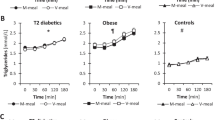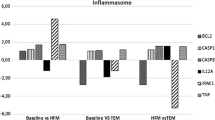Abstract
Purpose
Postprandial metabolic stress as a consequence of ingestion of high-energy meals is recognized as an important risk factor for cardiovascular disease. The objective of this study was to evaluate the inflammatory and antioxidant response of the body to the acute ingestion of a high-fat meal (HFM).
Methods
Fifteen healthy overweight subjects were recruited for the study. After HFM consumption, plasma glucose, insulin, uric acid (UA), triglycerides (TG), total cholesterol (TC), thiols (SH), inflammatory cytokines (IL-6 and TNF-α) and dietary antioxidants were measured at 0, 0, 5, 1, 2, 4, 6 and 8 h points from ingestion.
Results
The ingestion of HFM induced significant increases in both TG and TC, with peaks at 4 h (p < 0.001) and 8 h (p < 0.01), respectively. IL-6 and TNF-α significantly increased postprandially, reaching maximum concentrations 8 h after meal consumption (p < 0.001). Whereas plasma concentrations of vitamins and carotenoids were not changed by HFM, SH and UA increased, peaking 2–4 h postingestion (p < 0.001 and 0.01, respectively). Increments of SH and UA were positively correlated with AUC for TG (Pearson coefficient 0.888, p < 0.001 and 0.923, p < 0.001, respectively).
Conclusions
Present results indicate that as a consequence of an excess of dietary fat, the body responds through an inflammatory reaction, which is accompanied by an increment of endogenous antioxidant defenses, mediated by UA and SH, but not by vitamins C and E and carotenoids. Although further studies are needed, results of the current investigation represent novel findings on endogenous strategies of redox defense from fat overloads.



Similar content being viewed by others
References
Zilversmit DB (1979) Atherogenesis: a postprandial phenomenon. Circulation 60:473–485
O’Keefe JH, Bell DS (2007) Postprandial hyperglycemia/hyperlipidemia [postprandial dysmetabolism] is a cardiovascular risk factor. Am J Cardiol 100:899–904
Node K, Inoue I (2009) Postprandial hyperglycemia as an etiological factor in vascular failure. Cardiovasc Diabetol 8:23–33
Eberly LE, Stamler J, Neaton JD (2003) Relation of triacylglycerol levels, fasting and non-fasting, to fatal and non-fatal coronary heart disease. Arch Intern Med 163:1077–1083
Schinkovitz A, Dittrich P, Wascher TC (2001) Effects of a high-fat meal on resistance vessel reactivity and on indicators of oxidative stress in healthy volunteers. Clin Physiol 21:404–410
Nappo F, Esposito K, Cioffi M et al (2002) Postprandial endothelial activation in healthy subjects and in type 2 diabetic patients: role of fat and carbohydrate meals. J Am Coll Cardiol 39:1145–1150
Esposito K, Nappo F, Marfella R et al (2002) Inflammatory cytokine concentrations are acutely increased by hyperglycemia in humans: role of oxidative stress. Circulation 106:2067–2072
Devaraj S, Wang-Polagruto J, Polagruto J, Keen CL, Jialal I (2008) High-fat, energy-dense, fast-food–style breakfast results in an increase in oxidative stress in metabolic syndrome. Metabolism 57:867–870
Lundman P, Boquist S, Samnegård A et al (2007) A high-fat meal is accompanied by increased plasma interleukin-6 concentrations. Nutr Metab Cardiovasc Dis 17:195–202
Burdge GC, Calder PC (2005) Plasma cytokine response during the postprandial period: a potential causal process in vascular disease? Br J Nutr 93:3–9
So A, Thorens B (2010) Uric acid transport and disease. J Clin Invest 120:1791–1799
Feig DI, Kang DH, Nakagawa T, Mazzali M, Johnson RJ (2006) Uric acid and hypertension. Curr Hypertens Rep 8:111–115
Feig DI, Kang DH, Johnson RJ (2008) Uric acid and cardiovascular risk. N Engl J Med 359:1811–1821
Nieto FJ, Iribarren C, Gross MD, Comstock GW, Cutler RG (2000) Uric acid and serum antioxidant capacity: a reaction to atherosclerosis? Atherosclerosis 148:131–139
Schafer FQ, Buettner GR (2001) Redox environment of the cell as viewed through the redox state of the glutathione disulfide/glutathione couple. Free Radic Biol Med 30:1191–1212
Di Simplicio P, Frosali S, Priora R et al (2005) Biochemical and biological aspects of protein thiolation in cells and plasma. Antioxid Redox Signal 7:951–963
Go YM, Jones DP (2005) Intracellular pro-atherogenic events and cell adhesion modulated by extracellular thiol/disulfide redox state. Circulation 111:2973–2980
Ashfaq S, Abramson JL, Jones DP et al (2006) The relationship between plasma levels of oxidized and reduced thiols and early atherosclerosis in healthy adults. J Am Coll Cardiol 47:1005–1011
Ellman GL (1959) Tissue sulfhydryl groups. Arch Biochem & Biophys 82:70–77
Margolis SA, Schapira RM (1997) Liquid chromatographic measurement of L-ascorbic acid and D-ascorbic acid in biological samples. J Chromatogr B Biomed Sci Appl 690:25–33
Stacewicz-Sapuntzakis M, Bowen PE, Kikendall JW, Burgess M (1987) Simultaneous determination of serum retinol and various carotenoids: their distribution in middle-aged men and women. J Micronut Anal 3:27–45
Maiani G, Pappalardo G, Ferro-Luzzi A, Raguzzini A, Azzini E, Guadalaxara A, Trifero M, Frommel T, Mobarhan S (1995) Accumulation of beta-carotene in normal colorectal mucosa and colonic neoplastic lesions in humans. Nutr Cancer 24:23–31
Ceriello A, Quagliaro L, Piconi L et al (2004) Effect of postprandial hypertriglyceridemia and hyperglycemia on circulating adhesion molecules and oxidative stress generation and the possible role of simvastatin treatment. Diabetes 53:701–710
Dekker MJ, Wright AJ, Mazurak VC et al (2009) Fasting triacylglycerol status, but not polyunsaturated/saturated fatty acid ratio, influences the postprandial response to a series of oral fat tolerance tests. J Nutr Biochem 20:694–704
Ebenbichler CF, Kirchmair R, Egger C et al (1995) Postprandial state and atherosclerosis. Curr Opin Lipidol 6:286–290
Vogel RA, Corretti MC, Plotnick GD (1997) Effect of a single high-fat meal on endothelial function in healthy subjects. Am J Cardiol 79:350–354
Peluso I, Raguzzini A, Villano DV, Cesqui E, Toti E, Catasta G, Serafini M (2012) High fat meal increase of IL-17 is prevented by ingestion of fruit juice drink in healthy overweight subjects. Curr Pharm Des 18:85–90
Ghoshal S, Witta J, Zhong J, de Villiers W, Eckhardt E (2009) Chylomicrons promote intestinal absorption of lipopolysaccharides. J Lipid Res 50:90–97
Burton-Freeman B (2010) Postprandial metabolic events and fruit-derived phenolics: a review of the science. Br J Nutr 104:S1–S1430
Muraoka S, Miura T (2003) Inhibition by uric acid of free radicals that damage biological molecules. Pharmacol Toxicol 93:284–289
Ames BN, Cathcart R, Schwiers E, Hochstein P (1981) Uric acid provides an antioxidant defense in humans against oxidant- and radical-caused aging and cancer: a hypothesis. Proc Natl Acad Sci USA 78:6858–6862
Whiteman M, Ketsawatsakul U, Halliwell B (2002) A reassessment of the per-oxy-nitrite scavenging activity of uric acid. Ann NY Acad Sci 962:242–259
Tsukada K, Hasegawa T, Tsutsumi S et al (2000) Effect of uric acid on liver injury during Hemorrhagic shock. Surgery 127:439–446
Shi Y, Evans JE, Rock KL (2003) Molecular identification of a danger signal that alerts the immune system to dying cells. Nature 425:516–521
Wannamethee SG (2005) Serum uric acid and risk of coronary heart disease. Curr Pharm Des 11:4125–4132
Oh J, Won HY, Kang SM (2009) Uric acid and cardiovascular risk. N Engl J Med 360:539–540
Cao G, Prior RL (2000) Postprandial increases in serum antioxidant capacity in older women. J Appl Physiol 89(3):877–883
Cardona F, Túnez I, Tasset I, Garrido-Sánchez L, Collantes E, Tinahones FJ (2008) Circulating antioxidant defenses are decreased in healthy people after a high-fat meal. Br J Nutr 100:312–316
Ueland PM, Mansoor MA, Guttormsen AB et al (1996) Reduced, oxidized and protein-bound forms of homocysteine and other aminothiols in plasma comprise the redox thiol status–a possible element of the extracellular antioxidant defense system. J Nutr 126(4 Suppl):1281S–1284S
Seres T, Ravichandran V, Moriguchi T, Rokutan K, Thomas JA, Johnston RB (1996) Protein S-thiolation and dethiolation during respiratory burst in human monocytes. J Immunol 156:1973–1980
Jones DP, Mody VC Jr, Carlson JL, Lynn MJ, Sternberg P Jr (2002) Redox analysis of human plasma allows separation of pro-oxidant events of aging from decline in antioxidant defenses. Free Radic Biol Med 33:1290–1300
Blanco RA, Ziegler TR, Carlson BA, Cheng PY, Park Y, Cotsonis GA, Accardi CJ, Jones DP (2007) Diurnal variation in glutathione and cysteine redox states in human plasma. Am J Clin Nutr 86(4):1016–1023
Acknowledgments
This work was supported by The Coca-Cola Company, Atlanta, USA.
Conflict of interest
The authors declared no conflict of interest.
Author information
Authors and Affiliations
Corresponding author
Rights and permissions
About this article
Cite this article
Miglio, C., Peluso, I., Raguzzini, A. et al. Antioxidant and inflammatory response following high-fat meal consumption in overweight subjects. Eur J Nutr 52, 1107–1114 (2013). https://doi.org/10.1007/s00394-012-0420-7
Received:
Accepted:
Published:
Issue Date:
DOI: https://doi.org/10.1007/s00394-012-0420-7




